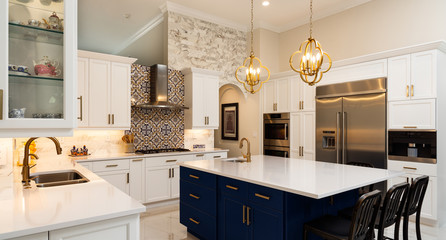A kitchen remodel can be as simple as painting cabinets and replacing faucets, or it could involve knocking down walls, reconfiguring plumbing, and creating a completely new footprint. Either way, a project of this magnitude should involve Kitchen Remodel Richmond VA.
Real estate agents can offer objective advice on design choices and share what upgrades buyers in your market seek.

The first step of a kitchen remodel is to tear out the old materials. This includes removing cabinets, countertops, appliances, sinks, and flooring. This may also include removing drywall and ceilings. The goal is to leave the room completely empty and clean for the renovation work to begin. It is important to cover and protect furniture, artwork, and anything else that is not nailed down to prevent it from being damaged during the demolition process. It is also important to disconnect and remove major appliances from the kitchen so they are not damaged during the tear out process.
This stage is often the most time-consuming part of the remodel. However, it is essential to the success of the project. The contractor should carefully plan the order of demolition to ensure that they are able to replace or reuse any components that can be salvaged. This will reduce the overall cost of the kitchen remodel and make sure that all necessary materials are available for the new construction.
It is important to properly shut off the electricity, water and gas before beginning any demolition. This will prevent accidental damage to the electrical, plumbing or gas systems and will help to ensure that any dangerous materials, such as asbestos, are removed safely.
While some homeowners may want to take on the demo themselves, it is generally best to hire a professional demolition company. They will have the proper tools and knowledge to complete the job correctly and efficiently. They will also be able to dispose of all unwanted materials properly, which will save you time and money in the long run.
When planning a kitchen remodel, homeowners should consider what kind of return they want on their investment. A minor kitchen facelift can be a quick and inexpensive way to update the look of a home, while more significant upgrades may add value but will require more upfront investment.
For example, replacing outdated or worn kitchen appliances and adding new lighting fixtures can increase a home’s resale value without the expense of a full replacement. In addition, spray foam insulation can improve a home’s energy efficiency and reduce airborne mold and dust.
As the name suggests, this phase is all about preparing the kitchen for what goes inside of it. In large remodel projects, this can be as simple as shifting walls around a new center island, but it can also mean moving plumbing fixtures feet away from where they originally sat. It’s a major part of the kitchen remodeling process and is typically done by a professional construction crew.
Rough-in can take anywhere from a few days to a week to complete, but it often feels like forever to homeowners. This is because there are many details involved, and the work must be inspected before it can continue.
This includes plumbing pipes and electrical wires, which are hidden behind the walls during rough framing but need to be rerouted to accommodate the new layout. It’s important to use licensed contractors for this step because of the technical nature of it.
The electrician can install new lighting, add circuits for more outlets, and upgrade the current ones to energy-efficient models. In addition to that, he or she can also install a new kitchen island, replace the appliances and more.
Depending on the scope of the project, it may also be necessary to reroute water supply lines. This can be a complicated and messy job. A plumber can help with this, but it’s a good idea to have a professional perform the rough-in plumbing.
Finally, the electrician can wire everything for light and power. This is a time-consuming task that needs to be done right, and a skilled electrician will ensure all the wiring is up to code.
Some property owners enjoy DIYing some parts of a kitchen remodel, but it’s usually best to leave the rough-in and framing to professionals. This helps ensure the remodel is done correctly and to code. It also gives the homeowner peace of mind knowing the work has been inspected and approved. In the end, a well-done kitchen remodel can add significant value to the home and be enjoyed for years to come. Considering that the average kitchen remodel recoups 56% of the cost upon resale, it’s an investment worth making.
Once the framing and plumbing portions of your kitchen remodel have passed inspection, it’s time to hang drywall. Depending on the scale of your project, this can be a relatively straightforward task. This is also the right time to add a coat of primer, even though you won’t be adding paint for a while. This helps seal the facing paper, protecting it against scuffs and scrapes while you install other elements in the room.
Drywall is constructed of sheets of gypsum encased between two pieces of heavy paper. It’s hung on wall and ceiling studs or joists with drywall screws, nails or glue. Workers conceal seams and imperfections in the drywall with joint compound or mud.
This step typically takes less than two weeks. If you’re skilled enough, you can hang drywall yourself. However, if you’re tackling a major kitchen renovation, you should consider hiring a professional. A contractor can ensure that your drywall is properly installed and will help you determine how much material to purchase for your project.
Before starting work on the drywall, it’s important to make sure that all water and gas pipes are turned off. If not, you could be faced with a costly and dangerous leak during the remodeling process. This is especially important if you’re making structural changes to your kitchen.
Next, you’ll need to tape and sand the drywall. For this, you’ll need a 6-inch finishing knife to apply a thin layer of mud over the drywall tape. Then, you’ll need to smooth the mud with the knife and sandpaper, creating a smooth surface that’s ready for painting.
In addition to applying mud, you’ll need to cover any holes or cracks in the drywall with patching products. There are several different types of patching materials, including fiberglass tape for straight seams and paper tape for inside corners. For larger holes, you may want to try using a corner bead product that has paper flanges attached to a metal bead.
At this point, you’re ready to start installing other kitchen components. This includes appliances, cabinet hardware and backsplash tile. This final stage typically only lasts about two weeks and involves putting the finishing touches on your new kitchen.
It’s time to install the final touches, such as cabinet hardware, light fixtures and paint touch-ups. This will take a week or so. Depending on how much of a makeover is being done, a backsplash could also be installed at this point. A kitchen remodeling project can be as simple as replacing existing cabinets and installing new appliances, or it could involve relocating plumbing lines, dropping walls, or stripping the room to the studs for a major reconfiguration. If this kind of work is required, it’s generally best to have professional design and contracting services on hand for the construction phase.
Some GCs who offer build service will also manage design projects for clients who need help creating a new layout. They may even provide a basic floor plan as part of their proposals for the project. It’s a good idea to get some quotes from several different contractors to ensure that you’re getting the best value and quality work.
Most DIY remodelers will hire subcontractors for the plumbing and electrical work. This is a wise move, as both trades require extensive training and licensing. Plus, rewiring and plumbing can present safety hazards if not done correctly.
If the project involves a complete reconfiguration, it’s a good idea to set up a temporary kitchen in a separate area of the home, such as an outdoor grill or a dorm-sized refrigerator and microwave. This will save time and money for dining out during the renovation.
Once the demolition and framing are completed, the installation process will start. It will include putting in the new countertops, sinks and cabinets. It will also likely include rerouting any necessary plumbing lines, such as when moving a sink to an island. In some cases, it will be necessary to replace old galvanized pipes with PEX or other more durable materials.
Once the new cabinets, counters and appliances are installed, it will be time to install the backsplash. This is a great opportunity to express your style, with a wide variety of materials and designs available. Backsplashes can range from classic subway tiles to marble to a more creative mosaic or concrete slab. Finally, a finishing touch like crown molding can be installed, if desired.

